RESEARCH & INNOVATION

ABSTRACT
The objective of this trial is to increase the pro- ductivity of the tea estate.
The productivity increase is achieved by increa- sing the emergence number of the actively gro- wing shoots.
The materials used in this trial are Novelgro Al- pha, Novelgro TERRA dan Novelgro Organic NPK.
Treatment:
Blok-2; area = 3800 m2
Red label Novelgro Organic NPK = 400 kg/ha for the first application, and the following appli- cation is subject to the plant development.
Novelgro TERRA = 1000 cc /ha/ 6 months
Novelgro Alpha+ = 1320 cc /ha/ 2 weeks
The TREATMENT has successfully increase the number of actively growing shoots into Peco Sho- ots by 2-2.5 times.
INTRODUCTION
Tea plant productivity directly related to numbers of harvestable Pecco shoots on every harvest period (40-45 days).
Usually there are 7 growing points at the leaves arm-pit for 7 leaved pecco shoots, which are potentials for new pecco shoots.
When the pecco shoots is picked at 3 leaves le- vel, there left 4 leaves with 4 growing points at their arm-pits.
And after the picking, the remaining growing points on the pecco shoots shall grow into new pecco shoots. So if a 7 leaved pecco shoots was
being picked at 3 leaves level, should give growth to 4 new shoots on the remaining 4 leaves arm- pit shoots into new pecco shoots

Plucked pecco shoots

(middle: Bird shoots, where there are buds of the shoots did not develop into new pecco shoots)
However, on the weak and old plants, there are only 2 arm-pit shoots that grow into new pecco shoots. And left behind the remaining arm-pit shoots dormant (not active).
As an illustration, from the 7 leaved pecco shoot, after the picking at 3 leaves level, there remain 4 leaves with 4 growing points at their arm-pit.
For the time being, the average numbers of the actively growing shoots are only 2 shoots. And if we can stimulate the development of all shoots growing points, which are 4 shoots growing po- ints, then the productivity will be doubled.
PRESENT TECHNIQUES
At present, the tea plant (camellia sinensis) cultivation technique in Taiwan is rely on high Nitrogen and NPK inorganic fertilizer and compost to stimulate the growth of pecco shoots. And the fertilizer application are scheduled for every 50 days or every after harvest.
Application Timing:
50 days 50 days 50 days
|---------------|---------------|---------------|------>so on.
NPK urea NPK urea
Teh Present Fertilizer Dosage:
365 days
NPK 15-15-15 /year =------------- x 40 g/plant = 146,0 g/plant/ year
100 days
365 days
Urea per year = ------------- x 30 g/plant = 109,5 g/plant per year
100 days
Total of inorganic fertilizer = 255,5 g/plant/year = 3750 kg/ha/year
NOVELGRO TECHNIQUES
The target of NOVELGRO treatment is to increase the number of actively growing arm-pit shoots into pecco shoots using:
- Novelgro Organic NPK which has Release- On-Demand properties, which will not induce any stress to the plant.
- Novelgro TERRA Soil Conditioner, which has soil healing properties to help worn out soil due to over fertilization by in-organic fertil- izer soil, to regain back its fertility. The dos- age is 1 liter/ha/6 months.
- Novelgro ALPHA Plant Growth Enhancer which will rejuvenate the exhausted and weakened tea plant’s cells, into fresh, healthy and productive cells. The dosage is 1320 cc/ha/ 2 weeks.
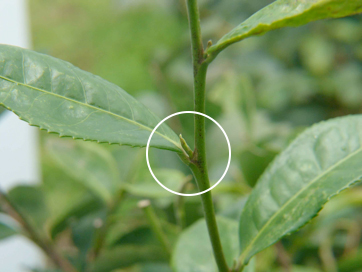
TRIAL EXECUTION
Treatment in Block-1 applied on 22-27 November 2008 and will be evaluated every week.
However, after evaluating the growth of Block-1 up until January 2009, a tentative conclusion taken that because the high frequency of rainfall by that time, it is observed that the application of Novelgro Alpha has been washed before it ends up absorbed into the plant. And the TERRA Novelgro dosage should be increased to overcome the effects of acid rain.

Above is tea plants before Block-2 treatment application; where there are plenty of dormant plucked shoots and no longer producing new pecco shoots.
Therefore, then it is decided to apply Treatment II in Block-2 and Block-1, which is a correction to the results of the evaluation of treatment I Block-1.
At this second treatment, growing substance is applied using the Alpha+ Novelgro formulated with special surfactants and a higher concentration of active substance. Dosage was 1320 cc/ha/2 weeks.
Block-2 treatment applied on 24 January 2009:Organic NPK Novelgro fertilizing treatment

Organic NPK Novelgro fertilizing treatment
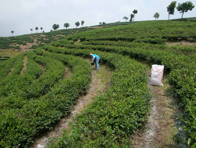
Novelgro Alpha+ spraying
OBSERVATION
These are how the plants looked after given the Treatment II in Block-1 and Block-2 on 21 February 2009. (4 weeks now 24 Januari 2009):
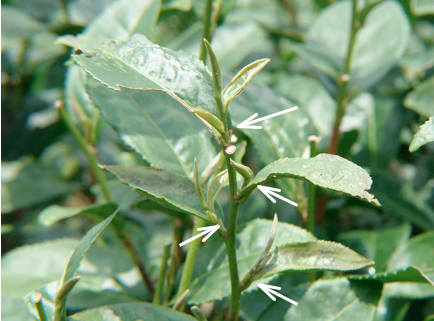
Above is tea plants after Block-1 and Block-2 treatment II application; as seen the growing bud eyes turn to active new shoots.

Pecco shoots of a control plant 21 Februari 2009)

Pecco shoots of a Treatment II plant. There are a lot of growing bud eyes. (21 February 2009)
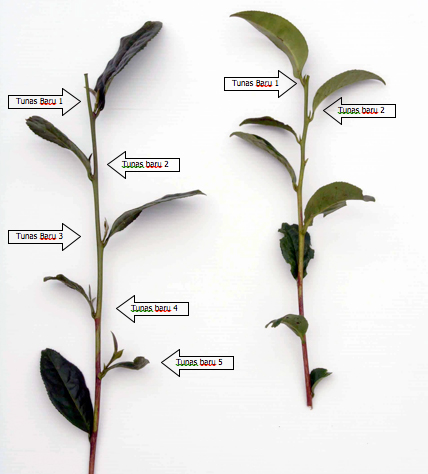
LEFT is the shoots from Treatment II (Novelgro) | RIGHT is the shoots from the control plants
CONCLUSIONS (until February 21th 2009)
This experiment has presented an obvious result that dormant eye buds can be activated by Novelgro.
While in the field, the average number of active buds after plucking the control plants was 2. At the same time, the average number of active buds of plucked stems in the Treatment II plants in Block-2 and Block-1 was 5. From the data taken, it is tentatively estimated that production capacity in the upcoming cycle will increase up to 2,5 times more than the current capacity. And in the next cycle, productivity will be increased according to the grade chain from 2 into 4 times, 16 times and so on.

Above is the condition of pecco shoots of the Treatment II plant. It is obvious there are a lot of new eye buds growing to be shoots (February 21th 2009).

Pecco shoots growth on 7th March 2009
The condition of treatment plants looked pretty satisfying and showed a significant development with an estimation of increasing crop in the next crop cycle. It is evident from the number of axillary buds that have developed into pecco shoots almost on every axil. Those buds then grow well without indicating any symptoms of deficiency.
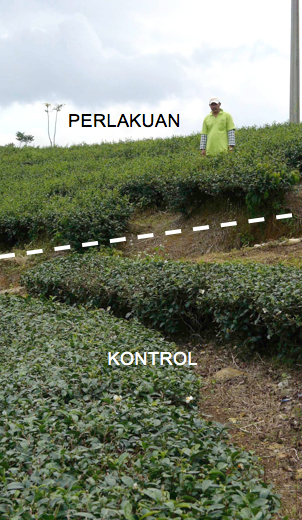
Above is the picture of control overlay and the treatment overlay full of pecco shoots.
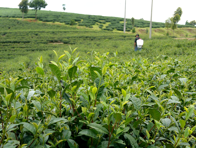
Overlay pecco shoots that are ready to be harvested in the near future.



